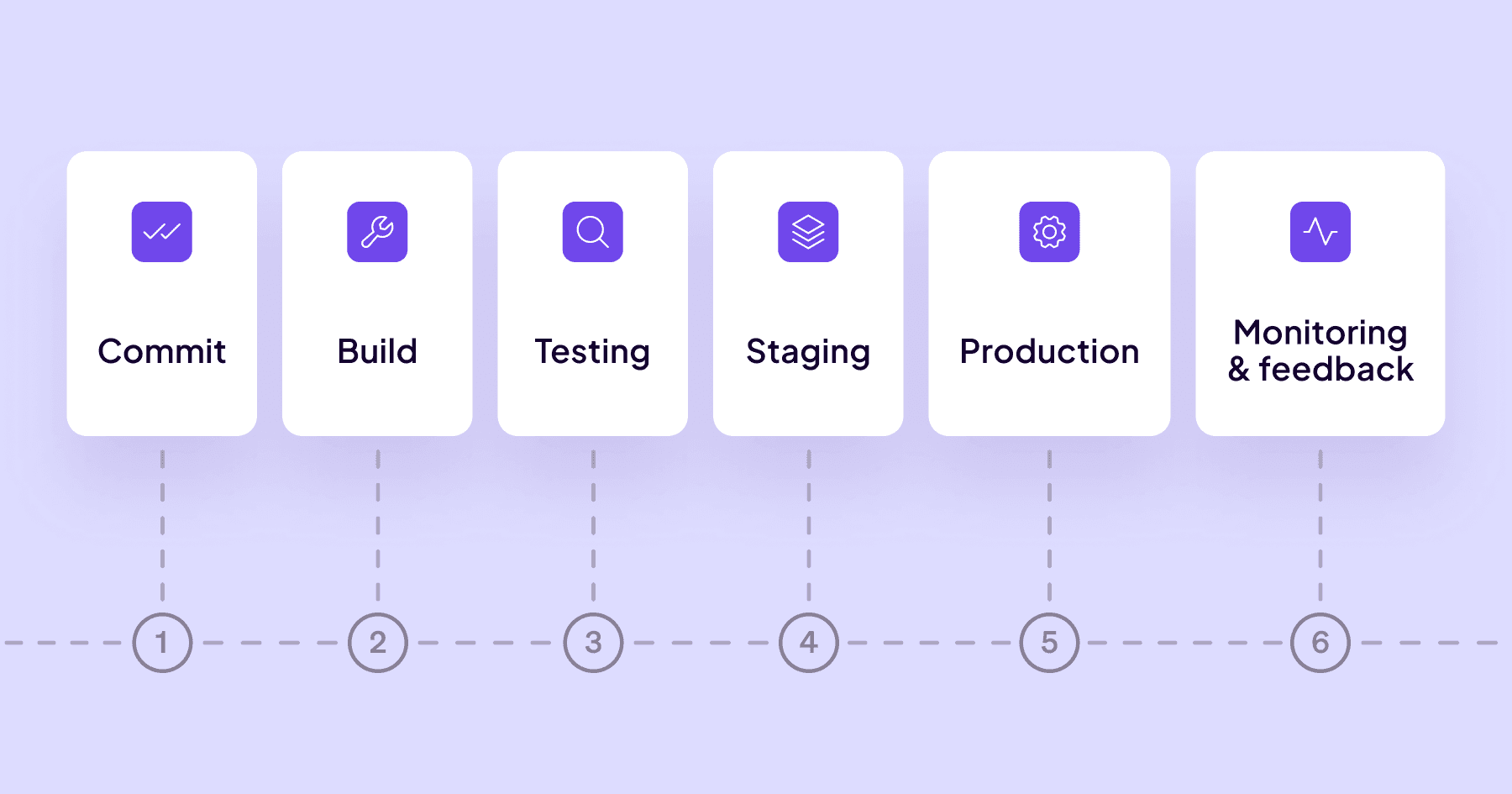DevOps practices have become essential for streamlining the journey from code to production. Development and operations teams work together to ship better software faster. But even with DevOps, getting source code from commit to production can face long lead times and scalability issues. That's where deployment pipelines come in, automating the journey and speeding processes up.
In this article, we’ll walk you through automating your deployment pipeline. We’ll explore how automation can reduce lead times, increase deployment frequency, and help your team scale.
What is a deployment pipeline?
A deployment pipeline is like a well-oiled machine that takes your code changes from version control to production. It's a series of automated processes that make software development consistent, reliable, and efficient. It also results in a better DevEx. Think of it as the backbone of DevOps practices, so teams can iterate, gather feedback, and deploy fast.
The main components of a deployment pipeline are:
Version control systems (VCS): Tracks and manages code changes, so multiple developers can collaborate at the same time.
Build server: Compiles and packages code automatically when changes are pushed to the VCS.
Automated testing: Catches defects and issues early in the development lifecycle.
Deployment automation: Ensures consistent deployment to various production environments, reducing manual errors.
6 key stages of a deployment pipeline
Code changes must pass through a deployment pipeline, which functions as a series of quality checkpoints. Each stage is there to make sure your new code works well with the existing system, passes all tests, and is ready for deployment. Continuous integration and continuous delivery/deployment (CI/CD) play key roles in a deployment pipeline. Let's break down the typical workflow:
1. Commit
Developers push their code changes to a VCS or source control system like Git, and the build server compiles the code and runs pre-build tasks. Tools like GitHub or GitLab can automatically kick off the pipeline once new code is committed.
2. Build
Next, it’s time for code compilation and creating deployable artifacts. Static code analysis is a way to examine source code without executing the program, and it identifies potential issues, such as security vulnerabilities. Once the code passes static analysis, build artifacts are generated. Continuous integration (CI) tools like Jenkins or CircleCI shine here, automating the build process and flagging any issues early on.
3. Testing
Automated testing tools replace manual testing methods. These run the gamut from unit tests to integration tests, to ensure the code is functional, high-quality, and reliable.
4. Staging
Your application is deployed to an environment that mimics production for final checks and user acceptance testing. This stage helps reduce manual errors. Tools like Docker and Kubernetes can help create consistent staging environments.
5. Production
If all previous stages are successful, your code is automatically deployed to production. Some companies use deployment strategies such as canary releases, feature toggles, or blue-green deployments to allow for easy rollback if there are problems. Configuration management tools like Ansible or Puppet can ensure smooth, repeatable deployments.
6. Monitoring and feedback
Once code is in production, it’s important to continuously monitor performance and stability. Monitoring tools like Prometheus or ELK stack keep an eye on performance, while user feedback help teams quickly identify and address any issues.
How to automate a deployment pipeline
Many teams struggle with managing manual deployments, which can be complex, difficult to scale, and prone to bottlenecks. Our State of Production Readiness 2024 report highlights the challenges in manual deployment processes: 56% of respondents cited manual follow-up as a blocker to production readiness, while 36% pointed to unclear ownership. These numbers paint a clear picture of the inefficiencies, confusion, and wasted time caused by manual processes. Automating your pipeline can tackle these issues head-on.
At its core, automating your DevOps pipeline means setting up a system that can smoothly move your code through various environments, from development to staging to production, with minimal human intervention. Feature flags allow you to control which features are visible in production, giving you the option to do gradual rollouts or quick rollbacks if needed. They reduce the risk when launching new features and make it faster to deploy new code, which means you can iterate faster on products and services for users.
Now, let's break down the steps to build a robust automated deployment pipeline.
Define your workflow
First, it’s important to map out your ideal deployment process. What steps does your code need to go through? What checks and balances do you want in place? Tools like draw.io or Lucidchart can help you visualize this process.
Why it matters: A well-defined workflow is your roadmap to success. It ensures everyone is on the same page and helps identify potential bottlenecks before they become headaches.
Choose the right tools
Look for DevOps automation tools that play well together and cover all aspects of your delivery pipeline. Popular choices include Jenkins or GitLab CI for continuous integration, Docker for containerization, and Kubernetes for orchestration.
Why it matters: The right tools can make or break your automation efforts. They should fit your team's skills, scale with your needs, and integrate seamlessly with your existing systems.
Automate the build process
Set up your chosen CI tool to automatically compile your code, run initial tests, and create deployable artifacts whenever new code is pushed. This is where tools like Maven or Gradle for Java, or npm for JavaScript, come into play.
Why it matters: Automating builds helps ensure consistency, catches basic errors early, and saves time.
Automate testing
Configure your pipeline to run a comprehensive suite of tests automatically. This includes unit tests, integration tests, and end-to-end tests. Automation tools like Selenium for UI testing or JUnit for Java can be invaluable here.
Why it matters: Automated testing catches bugs before they reach production and gives your team confidence to deploy frequently.
Automate deployments
Set up your pipeline to automatically deploy to various development environments if all tests pass. Tools like Azure, Terraform, or AWS CloudFormation can help manage infrastructure as code, ensuring consistent deployments.
Why it matters: Automated deployments reduce human error, speed up release cycles, and make rollbacks a breeze if needed.
Monitor and optimize
Keep an eye on your CD pipeline and application performance with continuous monitoring and logging. Use this data to continuously refine your process. Tools like Prometheus, Grafana, or ELK stack can help with this.
Why it matters: Monitoring helps you spot issues quickly and provides insights for ongoing optimization. It's like having a health tracker for your pipeline and application.
Remember, automating your deployment pipeline is a journey, not a destination. Start small, iterate often, and keep refining.
Why should you automate your deployment pipeline?
Automating your deployment pipeline dramatically cuts down the time it takes to get your code into production.
But speed isn't the only benefit. Automation also acts as a safety net, catching human errors that can slip through when you're doing things manually. The result? More stable software releases with less downtime. Plus, real-time monitoring and quick feedback loops help your team address issues quickly. It's a game-changer for rapidly improving your product and keeping your end users happy.
Automating repetitive, mind-numbing tasks that used to eat up your developers' time gives them time and mental energy to focus on what they do best: solving complex problems and building new features. To sum it up, here's an overview of the benefits you can expect when you automate your deployment pipeline:
Increased deployment frequency
Improved developer experience
Reduced human error
Improved consistency across deployments
Enhanced efficiency and reduced overhead for teams
Better scalability as organizational needs grow
Deeper insights and feedback from automated monitoring
Increased collaboration among development, testing, and operations teams
Best practices for automated deployment pipelines
Automating your deployment pipeline isn't always straightforward. Teams often face challenges like integrating a variety of tools, bridging skill gaps, and overcoming stakeholders’ resistance to change. But with the right approach, you can navigate these hurdles and smooth out the automation process. Let's dive into some best practices.
Maintain code quality standards
Set up automated code quality checks as part of your pipeline. This ensures that only clean, well-formatted code makes it through, and reduces the chances of issues. Remember, automation should improve quality, not compromise it.
Use Infrastructure as Code (IaC)
Treat your infrastructure with the same care as your application code. Use IaC tools like Terraform or AWS CloudFormation to define and manage your infrastructure. This approach makes your deployments more consistent, repeatable, and version-controlled. Plus, it's a lifesaver when you need to scale up or recover from disasters.
Regularly update and optimize pipeline configurations
Make it a habit to review and update your pipeline configurations. Look for bottlenecks, outdated tools, or unnecessary steps. Continuous improvement of your pipeline will help keep your operations efficient and effective.
Use an Internal Developer Portal (IDP)
An IDP streamlines the deployment pipeline automation by bringing all your tools and processes under one platform. It automates workflows and enforces standardized practices across operational and development teams. It helps keep everyone on the same page and improves overall efficiency.
How Cortex can help automate your deployment pipeline
When it comes to streamlining your deployment pipeline automation, Cortex centralizes and automates workflows for engineering teams so you can launch faster, without friction, for better DevEx.
These Cortex features will help you automate your deployment pipeline:
Catalog: The Catalog provides an up-to-date view of service ownership information and status in one place, which is crucial for version control and standardization.
Scorecards: Scorecards enable you to not only define best practices for launching new software, but continuously monitor alignment to these standards long after launch. Combine inputs from all of your favorite security, monitoring, CI/CD, logging, etc tools to create multi-faceted standards targeting specific entities or teams.
Workflows: The Workflows feature allows developers to chain together an unlimited number of actions across all your tools and teams, to reduce friction for Devs, approvers, and your business as a whole.
Scaffolder: The Scaffolder feature enables users to leverage project templates containing pre-defined boilerplate code, which covers input validation, tracking, catalog integration, and more. Pair Scaffolding with Workflows as a step in your process to remove friction from production readiness flows.
To learn more about Cortex, book a demo.






